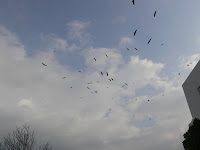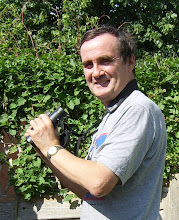



As often as not when in Spain I awake with every intention to go off birding somewhere, but this resolve frequently lasts only as long as it takes me to investigate the view from the terrace. To a large degree this is because it is simply the most convenient spot from which to see raptors. To date I’ve seen seventeen bird of prey species from the terrace (Griffon & Egyptian Vultures, Osprey, Short-toed & Booted Eagles, Red and Black Kite, Marsh and Montagu’s Harriers, Common and Honey Buzzards, Goshawk, Sparrowhawk, Common and Lesser Kestrels, Hobby and Peregrine). Frustratingly I’ve had Hen Harrier fly over the edge of the village plus Black-winged Kite, Bonelli’s Eagle and Merlin within a few minutes drive Although my maximum species total for any one day has been “only” 12 species, the numbers of birds seen must run into hundreds. Lesser Kestrels often provide much of the entertainment and the chance of good views of this charismatic little falcon that draw me to the terrace and the lure of passing migrant birds of prey that keeps me there.
Being big broad winged birds vultures don’t tend to be early risers (another advantage!) and generally drift into sight mid or late morning. This isn’t always the case as one memorable morning on 10th April 2007 demonstrated. I padded up to the terrace at about 8:00 without any expectation of seeing much more than Spotless Starlings and Lesser Kestrels particularly since the early morning mist had yet to dissipate. Both the expected birds were sitting in the trees opposite, but I was astonished to see Griffons circling round beneath the low cloud and even some sitting in trees below. In all some 200 birds were loafing about around the house. Even when the sun came out they stayed around to fly low over – and below – the terrace. It was a bizarre experience to look out of the downstairs windows and see one of these huge birds pass by at eye level!
In most birds in flight the head is held more or less level with the body, but with Griffon Vulture the long neck allows it to be carried well below the body line. This clear adaptation to their lifestyle isn’t obvious on most views since you tend to see them as they sail effortlessly above. That morning as they paraded past the terrace not only did they demonstrate the extraordinarily good view they had of what passed below them, but also, somewhat disconcertingly, swivelled their head and neck to get a better look at what was behind them! They might look big in most circumstances, but at that range they were damn enormous! It was a relief to reflect that they prefer their food to be dead before they move in!
Although this encounter with such a large number of low flying vultures was remarkable, seeing them glide low over the house isn’t too unusual. In fact, I’ve never seen them so close anywhere else. This is another reason to stay put along with the fact that one of the earliest records of Rüppell’s Vulture in Spain was from Alcala. Naturally, it helps that there’s a constant supply of food and drink nearby!
Being big broad winged birds vultures don’t tend to be early risers (another advantage!) and generally drift into sight mid or late morning. This isn’t always the case as one memorable morning on 10th April 2007 demonstrated. I padded up to the terrace at about 8:00 without any expectation of seeing much more than Spotless Starlings and Lesser Kestrels particularly since the early morning mist had yet to dissipate. Both the expected birds were sitting in the trees opposite, but I was astonished to see Griffons circling round beneath the low cloud and even some sitting in trees below. In all some 200 birds were loafing about around the house. Even when the sun came out they stayed around to fly low over – and below – the terrace. It was a bizarre experience to look out of the downstairs windows and see one of these huge birds pass by at eye level!
In most birds in flight the head is held more or less level with the body, but with Griffon Vulture the long neck allows it to be carried well below the body line. This clear adaptation to their lifestyle isn’t obvious on most views since you tend to see them as they sail effortlessly above. That morning as they paraded past the terrace not only did they demonstrate the extraordinarily good view they had of what passed below them, but also, somewhat disconcertingly, swivelled their head and neck to get a better look at what was behind them! They might look big in most circumstances, but at that range they were damn enormous! It was a relief to reflect that they prefer their food to be dead before they move in!
Although this encounter with such a large number of low flying vultures was remarkable, seeing them glide low over the house isn’t too unusual. In fact, I’ve never seen them so close anywhere else. This is another reason to stay put along with the fact that one of the earliest records of Rüppell’s Vulture in Spain was from Alcala. Naturally, it helps that there’s a constant supply of food and drink nearby!










.jpg)



